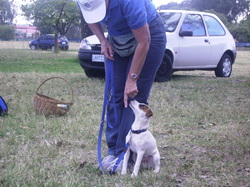Getting the most out of your dog walks?
By Candi Moon
WWW.FURBABIESTRAINING.CO.ZA
Candi runs Furbabies one of our Recommended Puppy Schools in the Auckland Park / Melville areas. CLICK HERE to find out more about them
WWW.FURBABIESTRAINING.CO.ZA
Candi runs Furbabies one of our Recommended Puppy Schools in the Auckland Park / Melville areas. CLICK HERE to find out more about them
TAKE ADVANTAGE OF YOUR DAILY DOG WALKS AND END UP WITH AN EVEN BETTER BEHAVED DOG

.
Your dog’s walks are a really great time to work on her training.
One reason for this is that dogs don’t generalise as well as we do. For example, if you always ask your dog to sit in the kitchen to receive his dinner, that forms his picture for the ‘sit’ command. ‘Sit’happens in the kitchen with you standing in front of him holding his dish. If you ask this same dog to sit in the garden and he looks at you blankly, he is not being naughty; he just has not learnt to sit in any other place than the kitchen where his food bowl is one of the cues and you standing in front of him another.
To generalise a ‘sit’ your dog should be taught to sit in every room of the house and with you in different positions, sitting, standing, and even lying down, so that the dog learns the only important variable is the command and/or hand signal to sit, and that your position and the room she is in are not part of the equation.
Walks are a great time to generalise commands, as every few steps is a new place as far as your dog is concerned. Practicing several sits over the course of the walk will help the dog to generalise this command very quickly.
Another reason why training on walks is great is that it teaches your dog to focus on you to find out what you would like her to do next. This results in a much calmer and more controllable dog.
It also lets your dog know that you will let her know what to do in any situation and that she doesn’t need to take matters into her own paws. For example, if you are walking past a gate with a barking dog on the other side you can ask your dog to focus on you and to heel past the gate. This teaches her that you will take care of this stressful situation and that she does not need to retaliate by barking and lunging defensively.
As there will be lots of distractions on walks, like other dogs, people, cars etc. you will start to ‘proof’ your training against distractions. A dog who can do their obedience exercises perfectly at home but goes ballistic as soon as he walks out of the gate is really unpleasant to walk. With patience and consistent training on walks this problem can be solved.
Training with treats on walks is especially useful for nervous dogs as they begin to associate their walks with the yummy treats and fearful feelings change over time into ones of happiness and anticipation.
Some suggestions on using training on walks:
- If you have a lively dog, ask them to sit often, this will help the dog to calm down and increase their focus.
- Again, if you have a lively dog, who may bark and pull on leash, a couple of down stays at the beginning of the walk will result in a much calmer dog.
- When walking down busy roads, and past other dogs on leash or barking at gates, ask you dog to make eye contact with you and heel, then let them resume walking normally once you are past the distraction.
- If your dog reacts to other people, dogs, bicycles etc. ask your dog to make eye contact with you to break their focus on the distraction. This works best if you ask for eye contact as soon as your dog spots and distraction, but before they start reacting to it.
- When crossing roads ask your dog to sit at the kerb and then heel across the road with you, this will eventually train your dog to sit at any kerb and wait, a great one for safety if your dog ever gets out by accident.
- Ask your dog to sit to have his leash put on, sit for you to open the gate and sit nicely while you close it, then begin your walk. This rewards your dog for their calm behaviour rather than taking out a dog who goes crazy with excitement on seeing the leash and is then rewarded for acting like a lunatic by being taken on a walk, which will result in the behaviour getting worse over time.
Hard to Train - Some dogs and breeds are just harder to train than other dogs. Here is a great article that gives you tips and ideas as to how to overcome this.
.....................................................................................................................................................................................
To Tug or not to tug - some people say that having tugging games with a dog is wrong - it is or are there just some basic guidelines you should follow?
......................................................................................................................................................................................
Trigger stacking: how we set our dogs up to fail - we do this so often and dont even realize it, especially in the case of a dog that is just brought into our home. Here are some pointers for you.
